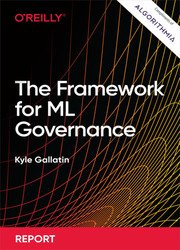 Название: The Framework for ML Governance: A Practical Guide for Implementing AI and ML Governance
Название: The Framework for ML Governance: A Practical Guide for Implementing AI and ML GovernanceАвтор: Kyle Gallatin
Издательство: O’Reilly Media, Inc.
Год: 2021
Язык: английский
Формат: pdf, epub
Размер: 10.1 MB
Most companies don't have problems building and deploying algorithmic models, but they do struggle to effectively manage them in production. Maximizing the value of machine learning projects in the enterprise requires a robust MLOps program. But there's one key challenge: The problem MLOps sets out to solve isn't just about technology. It's also about process.
The last decade has brought a dramatic boom of machine learning (ML) in both academia and enterprise. Companies raced to build data science departments and bring the promises of artificial intelligence (AI) into their decision making and products.
However, ML remained (and for some, remains) fundamentally misunderstood. Not long after companies began their foray into the realm of ML, they began to experience significant roadblocks to driving value and delivering ML projects. In 2015, Google released the now-famous paper “Hidden Technical Debt in Machine Learning Systems.” The paper outlined the common challenges data science groups faced with technical debt, DevOps, and governance of their ML systems.
Organizations hired data scientists in spades and started to generate algorithms. However, there were no existing operational pipelines capable of delivering models to production. This created a bottleneck that began to compound under the growing weight of new algorithms with nowhere to go. AutoML and other ease-of-use frameworks have further commoditized ML to the point that companies can now train hundreds of algorithms with the click of a button. Without a scalable framework to deliver and support models in production, the exponential explosion of ML models creates more problems than it solves.
Contents:
Скачать The Framework for ML Governance: A Practical Guide for Implementing AI and ML Governance
